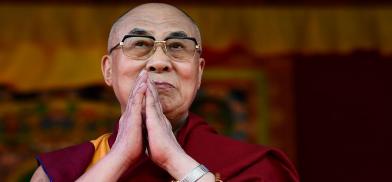Dalai Lama turns 87: Should India continue to keep him at arm's length?
The Chinese Communists were never shy in shaking hands with insurgents and rebels from India. In contrast, the Dalai Lama has never wielded a weapon. In that sense, he is also a Mahatma Gandhi, writes M.R. Narayan Swamy for South Asia Monitor

If China was not atheist, the entire Communist leadership must be now praying for an early demise of the Dalai Lama, the highly venerated Tibetan spiritual icon who turned 87 on Tuesday, July 6.
The shortsightedness of the Communist Party of China (CPC), including its legendary leader Mao Zedong, is primarily to blame for turning the Dalai Lama from one who once desired to join the CPC - which is now celebrating its centenary - to a one-man army now pitted against Beijing.
As is their wont, the Chinese Communists, primarily Han chauvinists, were so heady after the 1949 victory in the country's civil war that they did not waste much time in running over the sprawling Tibet, knowing well that the opposition was militarily too weak. Even as the first of Chinese troops marched into Tibet carrying portraits of Mao and Chou En-lai, Lhamo Thondup, born on July 6, 1935, was only preparing to take up the mantle of the 14th Dalai Lama, mind you without China playing any role.
The young Dalai Lama, spiritually inclined from childhood, showed exemplary courage in accepting an invite from the CPC – much against the wishes of his aides who feared for his safety – and went to Beijing to meet Mao. Over 10 days, he had several meetings with the Communist chieftain and met other leaders of the revolution. The limited experience was enough for the Dalai Lama to conclude that Communism was not for him.
Not only were the promises by Mao to let the Tibetans govern themselves not adhered to, but the Communists also began to tear apart the highly religious Tibetan society with mindless savagery, sparing not even women and children.
After years of trying to put up with an aggressive Chinese leadership, the Dalai Lama executed the only option available to him: escape. Fooling the Chinese, he undertook a strenuous but successful long march to India, crossing over to India on 30 March, 1959.
Mao, with decades of political experience behind him, rightly prophesied that China had lost half the battle by letting the Dalai Lama escape. The Dalai Lama has proved Mao right.
Face of resistance against China
Over the more than 60 years he has spent in self-imposed exile, with not one country recognizing his administration, the Dalai Lama has acquired a stature that simply overwhelms Chinese propaganda over Tibet.
It wasn’t always like this. In the initial years of “Tibet’s liberation”, with the revolutionary tag still fresh in Chinese Communist hands, many around the world did believe that the Dalai Lama was a reactionary feudal who had to go. Even as China galloped from strength to strength - despite repeatedly blundering along the way - the Dalai Lama turned his grand isolation into strength to become the face of resistance ranged against the mighty Beijing.
In the process, a man who had been courted so much by Mao turned into an “imperialist dog” and “splittist”. The verbal aggression was proof enough that the Dalai Lama was causing the Communists immense pain.
So much pain that China – atheist otherwise and which has destroyed numerous Buddhist monasteries in Tibet – has now declared that it will vet the successor to the current Dalai Lama.
India's role and duty
While India has provided a safe sanctuary to the Dalai Lama and a vast Tibetan diaspora, numbering nearly 100,000, it seems to be too conscious of the Chinese shadow, so much so that it now maintains a visible distance from the Nobel Peace Prize winner.
In contrast, the Dalai Lama has always told the world – and his followers in particular – that they need to be very mindful of Indian sensitivities and that the Tibetans are immensely grateful to India for all that it has done for them.
I have met the Dalai Lama more than once and interviewed him too. For a spiritual leader, he is full of life; his boisterous laughter – he looks like a child when he laughs his heart out -- can obliterate all worries. It is probably years of meditation and Buddhist scholarship that a man so burdened by Chinese excesses on his people and land resembles one who has no apparent care in the world.
When China insisted that it will decide the Dalai Lama’s successor, he wondered why Beijing was so worried over a successor when he had no plans to die anytime soon.
The Chinese Communists were never shy in shaking hands with insurgents and rebels from India. In contrast, the Dalai Lama has never wielded a weapon. In that sense, he is also a Mahatma Gandhi.
So, as he celebrates his birthday, India must wish him well. That will not make China happy. But, then, will China ever be happy with India?
And if and when the Dalai Lama breathes his last, India must pay him the same respect that it gave to the Catholic nun Mother Teresa, another Nobel Peace Prize winner who founded the Missionaries of Charity, when she passed away. Any discrimination will show New Delhi in poor light.
(The writer is a veteran journalist who writes on diplomacy and politics. The views expressed are personal. He can be contacted at ranjini17@hotmail.com)









Post a Comment